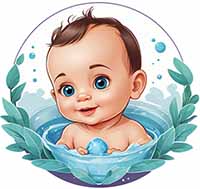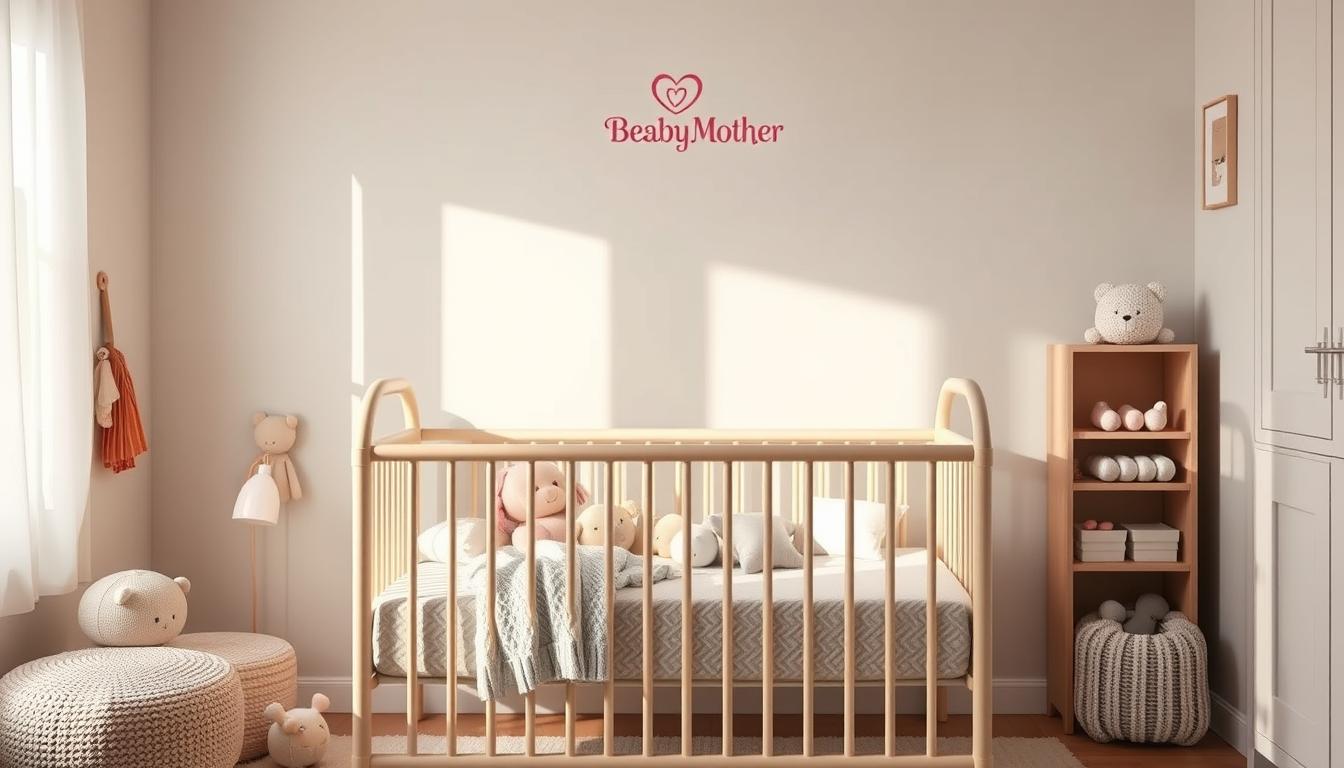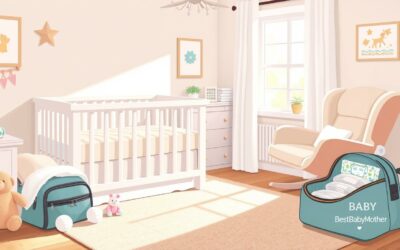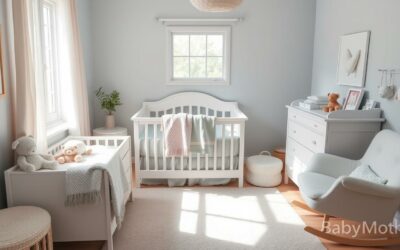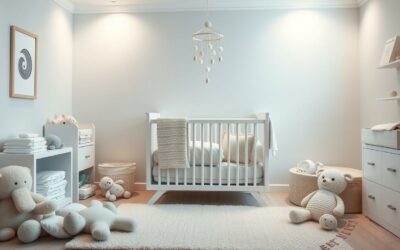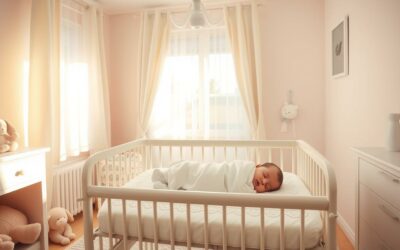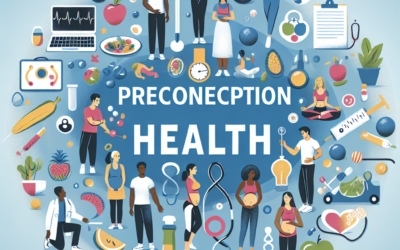What are the most common mistakes new parents make when it comes to ensuring the safety of their newborn? Welcoming a baby into the world brings joy and big responsibilities. You’re likely getting lots of advice on infant care. But how do you sort it all out to keep your baby safe?
Keeping your baby safe starts with a safe place and knowing about nursery safety. You need to handle your baby carefully and keep things clean. Here, you can find tips on how to prepare well.
Your journey includes getting help after delivery, keeping the nursery clean, and taking care of yourself. Nationwide Children’s says it’s key to know about choking hazards and sleep safety. Your pediatrician is also a big help, offering important advice.
Key Takeaways
- Newborns sleep about 16 hours a day, making safe sleep spots very important.
- Car safety seats must be installed and used right, as 46% are not.
- Babies should always sleep on their backs to lower SIDS risk.
- Washing your hands before holding your baby can stop infections.
- Childproofing your home stops dangers like choking and falls.
Handling Your Newborn
Keeping your baby safe and healthy is very important. They are very delicate. You must always handle them carefully to keep them safe.
Supporting the Head and Neck
When you pick up your baby, make sure to support their head and neck. Place one hand under their head and the other under their bottom. Bend your knees to protect your back.
Once you have your baby in your arms, hold them close to your chest. This keeps their head safe. Also, move your hand up to support their neck. Never hold hot drinks or cook while holding your baby.
Proper Hand Hygiene
Keeping your hands clean is key for your baby’s health. Babies can easily get sick because their immune system is still growing. Always wash your hands with soap and water before touching your baby.
If you can’t wash your hands, use hand sanitizer. Make sure everyone who holds your baby also washes their hands. Clean things your baby touches often to keep them safe.
Safe Handling Practices
It’s important to handle your baby safely. When using a carrier or stroller, make sure the straps are tight. If you need to wake your baby, gently tickle them or softly blow on their cheek.
Teach older kids and grandparents how to hold your baby safely. Ask them to sit down before holding the baby to avoid dropping them.
By following these tips, you can keep your baby safe and healthy. This creates a loving and safe place for them to grow.
Baby Proofing and Childproofing
Creating a safe space for your baby is key. This means baby proofing and childproofing your home. Most parents start this when they’re expecting or right after their baby is born. It’s important to keep your home safe to avoid accidents.
Every year, about 20,000 kids under 5 go to the emergency room because of accidents. These accidents can be prevented with good babyproofing.
Basic Baby Proofing Tips
Begin with simple steps like locking cabinets and putting up safety gates. Since most accidents happen from falling objects or furniture, make sure to secure TVs and furniture. Also, lower your water heater to 120 degrees Fahrenheit and install smoke and carbon monoxide detectors on every floor.
Childproofing Different Rooms
Every room has its own dangers. So, it’s important to tackle them one by one. In the nursery, keep the crib clear of blankets and pillows for the first year. This is because 95% of parents worry about suffocation risks.
In kitchens, which are a big source of accidents, lock up drawers and cabinets. Use baby gates to block off areas like stairs and dangerous zones. Baby gate sales have gone up by 15% in the last year.
Essential Baby Proofing Products
Getting the right baby proofing products is crucial. It can cost between $200-500. Here are some must-haves:
- Corner guards and protective bumpers for sharp furniture edges
- Cabinet locks and drawer latches to secure harmful substances
- Outlet covers to prevent electrical hazards, as 70% of children face these risks
- Window guards to prevent falls
- Pool or hot tub barriers to prevent drowning incidents
- Locks for medications, alcohol, and poisonous products
- Disabling bathroom door locks or ensuring easy external access
By following these steps and using the right products, you can make a safe space for your baby. For more tips, check out KidsHealth.
Newborn Safety
Keeping your baby safe is very important. Safety experts give us key steps for safe sleep practices and keeping your baby healthy.
Stopping SIDS is a big worry for parents. The American Academy of Pediatrics says to put your baby on their back to sleep. This lowers the risk of sudden unexpected infant death (SUID). Also, sleeping in the same room as your baby without sharing a bed is safer.
It’s crucial to baby-proof your home. Use baby gates at both the top and bottom of stairs to stop falls. Don’t use baby walkers because they can cause injuries. Make sure all second-hand items are safe for your baby.
“Proper installation of infant car safety seats is crucial, yet only 70% of car seats are installed correctly, as per national safety standards.” — National Highway Traffic Safety Administration
Always watch your baby, especially when bathing. Even a little water can be dangerous. Keep the water warm, between 96-100 degrees Fahrenheit, to avoid burns.
- Avoid foods like peanut butter, hot dogs, and grapes until the age of 4 due to choking hazards.
- Keep small items such as coins, buttons, and safety pins out of your child’s reach.
Good safe sleep practices mean more than just how your baby sleeps. Make sure their room is not too hot. Doctors say not to use products that claim to prevent SIDS, as they might not work.
| Key Area | Guidelines |
|---|---|
| Sleeping Position | Put baby to sleep on their back to reduce the risk of SUID. |
| Supervision | Never leave baby unattended on high surfaces or during bath time. |
| Baby-Proofing | Install baby gates at stairways and avoid baby walkers. |
| Car Safety | Ensure car seats are correctly installed and meet safety standards. |
By following these steps, you can create a safe and loving space for your baby.
SIDS Prevention and Safe Sleep Practices
It’s key to follow safe sleep tips to prevent SIDS and keep your baby safe. These practices help lower the risk of sleep-related deaths, like SIDS.
Sleeping Position and Environment
The way your baby sleeps is very important. Studies show that babies who sleep on their backs are safer. This is because they are less likely to die from SIDS than those who sleep on their stomachs or sides.
Make sure the sleep area is clear of soft things like pillows and blankets. These can cause suffocation or make the baby too hot. It’s also important to keep the room cool. Too many clothes or bedding can make the baby too warm.
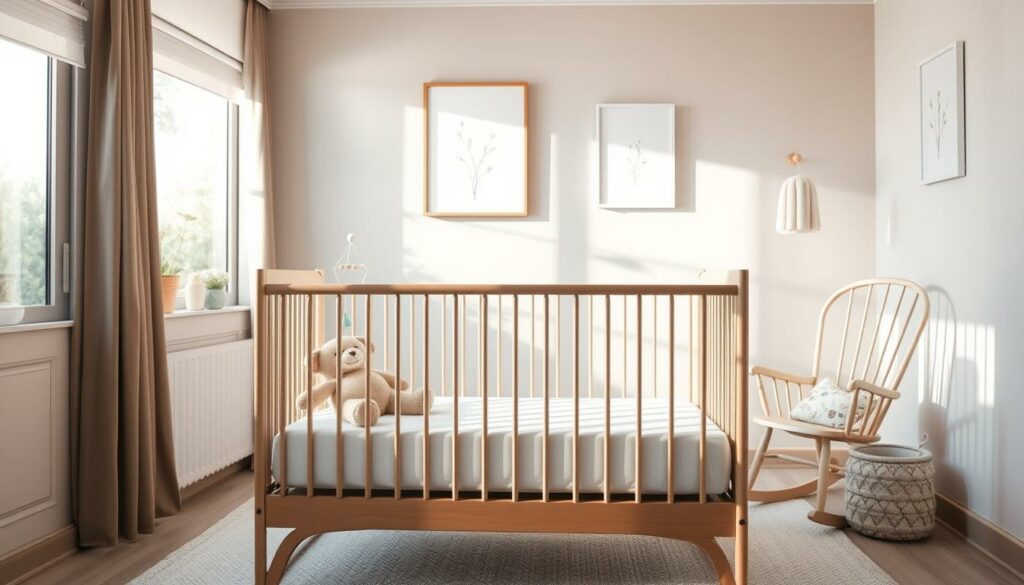
Use of a Pacifier
Using a pacifier at nap time and bedtime can help prevent SIDS. Research shows that pacifiers can lower the risk of SUIDs, which includes SIDS. It’s not fully understood how pacifiers help, but they might keep airways open or protect against suffocation.
Room Sharing Recommendations
Experts say it’s best to have the baby’s sleep area in your room for the first 6-12 months. But, they should not share the bed. This is safer than bed sharing. It lets you keep an eye on your baby and feel more at ease, while also lowering SIDS risk.
Following these safe sleep tips and sharing them with others who care for your baby is crucial. It helps prevent SIDS and gives your baby a safe start in life.
Infant Bathing Safety
Keeping your baby safe during bath time is very important. Follow the right steps to make bath time safe and fun for both of you. This means getting ready carefully, keeping the water at the right temperature, and always watching your baby.
Preparing for the Bath
Getting ready is the first step for infant bathing safety. Have everything you need close by, like a safe tub, baby soap, soft cloth, and towel. The World Health Organization says wait 24 hours after birth for the first bath. For the first year, bathe your baby three times a week to keep their skin moist.
When the umbilical cord stump falls off, you can start using a tub for full baths.
Proper Water Temperature
It’s very important to have the water at the right temperature for infant bathing safety. Make sure the water is not too hot. Use warm water and check it with your wrist or a thermometer.
Wet babies are slippery, so always hold them to keep them safe.
Supervision During Bath Time
Never leave your baby alone in the bath, not even for a second. Most child drownings happen in bathtubs, especially with babies under 1. It can take just 3 seconds for a baby to slip into danger.
So, watching your baby closely is very important for infant bathing safety. After the bath, empty the tub and keep bathroom doors closed to avoid accidents. Learning CPR can also help you in case of an emergency.
Crib Safety Guidelines
Keeping your baby’s crib safe is very important. It helps prevent accidents and makes sure they sleep well. The American Academy of Pediatrics (AAP) says to use a crib that meets safety standards. Make sure to buy a crib that is new and follows the Consumer Product Safety Commission (CPSC) rules.
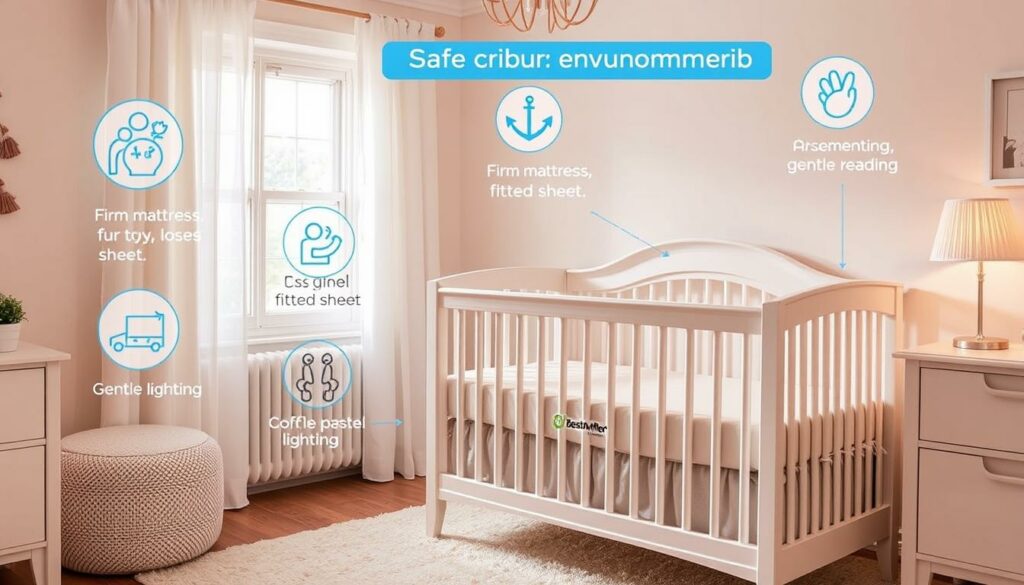
Important crib safety tips include using a firm mattress and a tight sheet. The crib should have no soft things or loose bedding to avoid suffocation. Always check the crib for damage or loose parts. Here are some key guidelines:
- Crib slats should be no more than 2 3/8 inches apart to prevent a baby’s body from fitting through them.
- All crib slats should be present and in good condition.
- Corner posts should not be more than 1/16th inch high to avoid clothing entanglement.
- Avoid cribs with cutouts in the headboard or footboard.
- Ensure the crib has no peeling or cracked paint.
- Firmly secure all crib hardware, including bolts and screws, with no sharp edges or rough areas.
- Avoid drop-side cribs due to identified safety concerns.
- The mattress should fit snugly and pass the two-finger test; if more than two fingers fit between the mattress and crib, the mattress is too small.
Also, setting up your nursery safely is important. Cribs made after 2011 meet strict safety rules. Place white noise machines at least 7 feet away from the crib and keep the volume under 50 decibels.
Don’t use bumper pads, wedges, positioners, or inclined sleepers. They are not safe for babies. Following these guidelines will make sure your baby has a safe place to sleep. This will give you peace of mind as a parent.
Bonding Techniques with Your Newborn
Creating a strong bond with your newborn is key in parenting. There are many ways to bond and strengthen your connection. These methods help your baby feel safe and grow well.
Skin-to-Skin Contact
Skin-to-skin contact, or kangaroo care, is great for bonding. It involves holding your baby close to your chest. This helps their heart rate and keeps them warm.
It also helps them sleep better. This kind of touch is very important right after they are born.
Gentle and Soothing Touch
Touching your baby gently can make them feel less stressed. Soft strokes can comfort them a lot. This touch helps their brain grow and strengthens your bond.
The more you touch your baby, the closer you’ll become.
Using Your Voice to Calm Your Baby
Your voice can calm your baby down. Soft talking, singing, and reading can make them feel safe. They love the sound of your voice.
It helps soothe them and builds a strong bond. Your voice and eye contact are powerful for connecting with your baby.
Managing Common Newborn Health Concerns
It’s important to know about health issues that can affect your newborn. The first four weeks of life are critical. With the right care, many problems can be managed well.
Recognizing Signs of Illness
Newborns often get colds, coughs, fevers, and vomiting. They can also have skin issues like diaper rash and cradle cap. Watch for signs like crying a lot, fever, being very tired, or acting strangely.
Most of these issues are not serious. But, it’s crucial to trust your instincts and watch your baby closely. If you see any concerning symptoms, call your pediatrician right away. Early action can make a big difference.
Importance of Immunizations
It’s vital to make sure your newborn gets all their shots. Vaccines protect them from serious diseases. Make sure to keep up with your baby’s vaccination schedule and talk to your doctor about any worries.
When to Call the Pediatrician
Knowing when to call the doctor is key. If your baby has a high fever that won’t go away, keeps vomiting, won’t eat, or is very upset, call your pediatrician. Also, watch for signs of trouble like not wanting to move or having trouble breathing.
It’s always better to be safe than sorry. If you’re unsure about your baby’s health, don’t hesitate to reach out to your doctor.
FAQ
How should I support my newborn’s head and neck?
Always make sure to support your baby’s head and neck. This is very important for their safety.
What are the steps for proper hand hygiene when handling my newborn?
Keeping your hands clean is key to stop infections in newborns. Wash your hands well with soap and water, or use sanitizer before touching your baby.
How can I safely handle my newborn during daily activities?
Do gentle activities and make sure your baby is safe in carriers and strollers. Never shake your baby to wake them. Use a soft touch or a cheek blow instead.
What are some basic baby proofing tips?
Start by securing cabinets and installing safety gates. Look for dangers in each room, like sharp edges and small objects. Use products like corner guards and cabinet locks to keep your baby safe.
How should I childproof different rooms in the house?
Check each room for dangers and fix them. In the kitchen, keep cabinets closed and sharp objects away. In the living room, cover outlets and pad sharp edges.
What essential baby proofing products should I invest in?
You’ll need corner guards, cabinet locks, outlet covers, and safety gates. These items help make your home safer for your baby.
What are the best practices for safe sleep to prevent SIDS?
Always put your baby on their back to sleep. Make sure their sleep area is safe from soft items. Consider using a pacifier and room-sharing but not bed-sharing for the first 6-12 months.
How does using a pacifier help in SIDS prevention?
Using a pacifier during sleep can lower SIDS risk. Make sure it’s clean and introduced after breastfeeding starts.
What are the recommendations for room sharing with my newborn?
Room sharing is recommended. Keep your baby’s sleep space in your room but not in your bed. Do this for the first 6-12 months to reduce SIDS risk.
What should I prepare for my newborn’s bath?
Use a secure, slip-resistant tub with 2-3 inches of warm water. Have all bath supplies ready to avoid leaving your baby alone.
How can I ensure the proper water temperature for my baby’s bath?
Check the water with your wrist or a thermometer. It should be warm but not hot. The ideal temperature is around 98.6 degrees Fahrenheit.
Why is supervision during bath time essential?
Never leave your baby alone in the bath. It’s dangerous and can cause drowning. Always keep a hand on your baby and drain the tub after the bath.
What are some key crib safety guidelines to follow?
Use a crib that meets safety standards. It should have a firm mattress and snug sheet. Keep it free from soft objects and check it regularly for damage.
How can skin-to-skin contact help in bonding with my newborn?
Skin-to-skin contact, or kangaroo care, helps your baby’s heart rate and calms them. It also strengthens your bond and emotional connection.
What are some gentle and soothing touch techniques for bonding with my baby?
Gently stroking your baby and using a soft voice can comfort and bond with them. These actions are soothing and good for their development.
How can I use my voice to calm my baby?
A soft and soothing voice can calm your baby. Singing lullabies or speaking softly can relax them.
What signs of illness should I be aware of in my newborn?
Watch for fever, lethargy, or persistent crying. These could mean illness. If you notice any, call your pediatrician.
Why are immunizations important for my newborn’s health?
Immunizations protect your baby from many diseases. Make sure they get all the vaccines during their check-ups.
When should I call the pediatrician for my newborn?
Call your pediatrician for any concerning symptoms, like breathing trouble, high fever, or dehydration. Your doctor can offer advice and help quickly.
